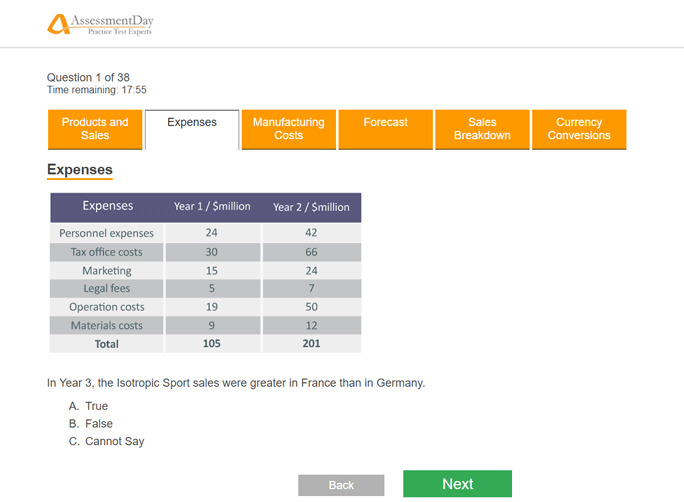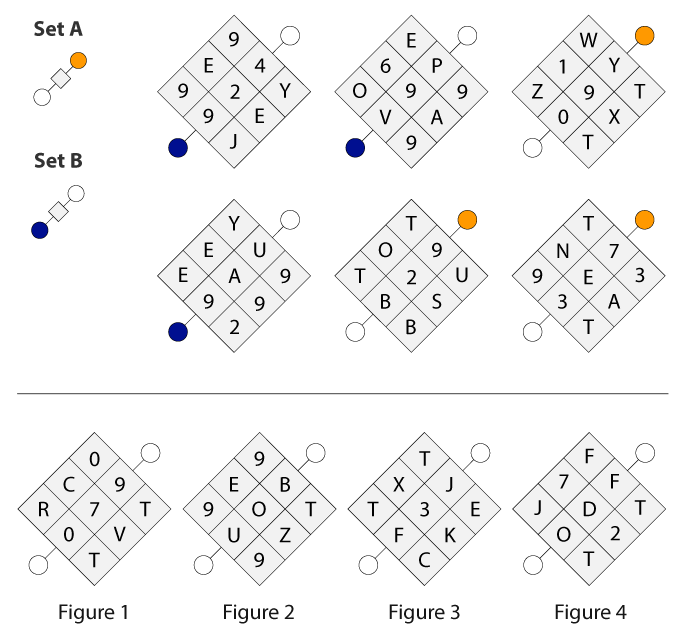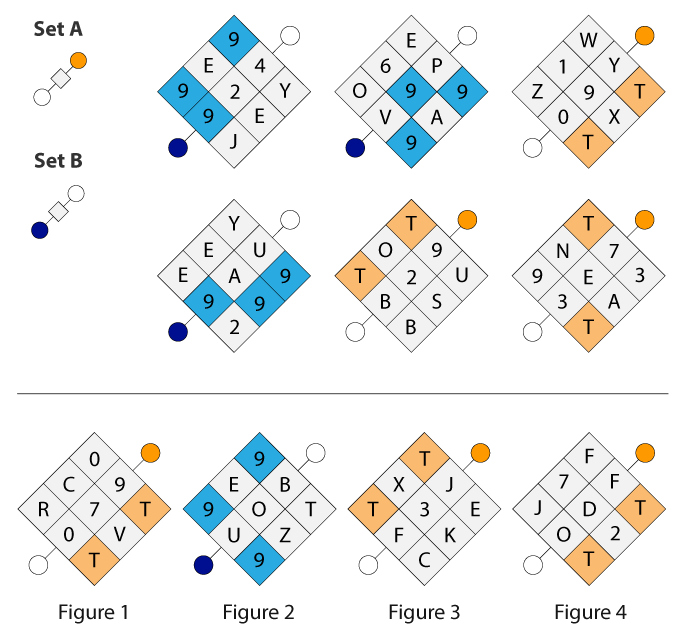Cut-e / Aon
Our guide to Aon covers all the different Cut-e assessments with explanations and advice on all the different tests you may face.

Page contents:
Jump to:Updated:
Note: AssessmentDay and its products are not affiliated with Aon / Cut-e. Our practice tests are intended only for candidate preparation, not for employee selection.
What is Cut-e/Aon
Aon provide psychometric tests (online and gamified) and personality questionnaires to help in the selection of candidates in the recruitment process and development of employees. Aon's tests are used across multiple sectors and administered to millions of people each year.
Are Cut-e and Aon the same thing?
Yes, in 2017 Aon acquired cut-e helping increase business efficiency and reach. Since then there has been a gradual change to cut-e assessments being marketed under the main brand name Aon. So if you ever see Aon assessments and cut-e assessments and wonder what the different is, there isn't any, they're the same company. You are more likely to see their assessments being described as cut-e assessments due to the familiarity consumers have with this brand name.
Did You Know
Cut-e use unique two or three letter codes for each style and we've followed the same codes here when describing the tests and when writing practice questions.
The different type of Aon assessments
Aon have an extensive range of psychometric tests that you could face in during your assessment. The type of tests you face will vary depending on the role and position you are applying for. Cut-e scales is the name given to Cut-e's main body of assessments that are numerical, verbal and logical. As each of these test types have lots of sub-tests within their main category we will talk about them under their test-type category for greater clarity.
Here is a list of the test types. We also provide free practise tests for some of the types:
Cut-e Verbal Reasoning (scales verbal)
Similar to your standard verbal reasoning test in that the answers are either 'True', 'False', or 'Cannot Say'. The differences here are that you can have up to 47 questions to answer in as little as 12 minutes, so this is a quick-fire test, don't hang around on questions for too long.
You can jump back and forth between any of the questions, so you are allowed to go back and change your answers. The answers to the questions can be found in the 8 or so tabs of images, graphs, tables, etc, you are provided with, so you may need to do quite a bit of searching to find the relevant piece of information.
Standard verbal reasoning tests will present you with large text extracts that you must read through to find the relevant information, Cut-e's verbal scales test will not involve large extracts, but instead will be part of the smaller tabs of information you are given.
Even though the formats are different, practising standard verbal reasoning tests will still be beneficial to your learning and preparation for this test. The skills involved still require strong verbal comprehension, but you may have to work a bit quicker for the cut-e test.
Cut-e Numerical Reasoning
There are two types of numerical test you could take:
scales numerical
The most common and more difficult test, you will be presented with tabs of different information - this will be data in the form of tables and charts. All the questions will have answers of either 'True', 'False' or 'Cannot Say'. It's your job to read the question, find the relevant information from the different forms of data and answer the question. If you believe there to be insufficient information, then the answer will be 'Cannot Say'.You will have 37 questions to complete in 12 minutes.
Here is a screenshot from one of our cut-e scales style numerical reasoning tests:

scales eql (digitChallenge)
It's less common you will have to face this test. This test is a short 5 minute test, assessing your basic numeracy. You will be given an equation with parts of it missing e.g. blank + blank = 8. You will have a selection of numbers to choose from between 1-9 to complete the equation. This test is super-easy and not one to worry about much.
Currently, we do not have any practise tests for this scales eql / digit challenge test, but brush up on your mental maths and you'll be quite well set for this one.
Master aptitude tests and become the #1 candidate
Get a completely free starter account
- Over 20 tests
- Track your progress

Cut-e Abstract Logical Scales
Cut-e's abstract/logical reasoning tests come in quite a few formats and have mish-mashed names depending on what they're measuring. Due to the complex names, be sure to double check which one you have to sit. They are all listed below:
Inductive-Logic (cls)
This is probably the most popular of cut-e's inductive logic series and we will cover this one in more detail. In each question you are shown 10 figures which each contain 9 letters and/or numbers. Six of these figures have already been assigned to either Set A or Set B (3 in each), and 4 are unassigned. You will be tasked with identifying what the rules are that determine whether a figure belongs to either set and assigning the remaining 4 figures. You will have to answer 12 questions in 12 minutes (thereby assigning a total of 48 figures to Set A and Set B collectively). You are not expected to finish the test so don't worry too much if you can't answer a few, it is created to be challenging and put you under time pressure. Examples of rules and interrelationships between figures could be:
- All Set X figures contain three of a specific letter or number.
- The only numbers used in Set X figures are odd or above/below a certain value
- All Set X figures contain specific letters/numbers e.g. 'ABC'.
Let's go over an example question, have a go at assigning the unassigned four figures to Set A or Set B (the answer will be below):

Now let's have a look at the answer...
We will highlight the commonalities between the figures to help you identify why the figures at the bottom belong to the relevant sets.

As you can see, the rule for Set A was two T's being placed in the corner positions, and for Set B there are always three 9's present.
We have four of these practice tests featured in our logical, inductive and bundle packs.
Inductive-Logic Practice Tests
To practise tests like cut-e's inductive-logic, you can find them within our logical, inductive or bundle packs. The bundle pack contains all our tests and so is recommended to those with several assessments/applications.
Deductive-Logic (lst)
Cut-e / Aon's scales series also features a similar abstract reasoning test: the Deductive-Logic (lst). These can be likened to a sudoku. Some changes to the well-known Japanese puzzle to complete as a short brain-tease during your evening commute can be seen quite quickly. The grid is much smaller at first and the numbers are replaced with shapes. Do not let this deceive you; these tests can rack up in difficulty quickly! The questions are all on either a 4-by-4 or 5-by-5 grid. Various shapes will be found in some squares of the grid, whereas other squares will be empty. Lastly, a question mark can be found in one of the squares. There are a few rules, similar to sudoku, which are explained to you beforehand. They are as follows:
- There must be one of every shape in each column
- There must be one of every shape in each row
- There must not be more than one of every shape in each column
- There must not be more than one of every shape in each row
The question will ask you to solve the short puzzle and deduce which shape would replace the question mark whilst following the rules stated above. You do not need to solve the entire grid, just that one space. There will be some easy questions and some much harder questions involving several steps to discover the correct answer.
Here's an example. Time yourself and see if you can work out which shape from the five shown below you can replace the question mark with?

Scroll down to see if you identified the correct shape...
1) The question mark is found in the fourth column which also contains a square and a cross. A star may also be found in the same row as the question mark. This leaves two options as to which shape could occupy the space of the question mark: a circle or a triangle.

2) There aren’t many triangles present in the grid, nor are there any circles at all, which makes attempting to solve one of these shapes quite tricky. Instead, it’s important to spot that the top row is only missing one shape to be complete. This missing shape is a circle.

3) This was useful information as now we can place a circle in the space of the question mark. We can see that this is definitely not the correct answer as placing a circle here would break one of the rules. The fourth column would then have two circles.

4) The correct answer must be a triangle. This is the only remaining option for our choice of shape.

There are an unknown number of questions to answer in a total of 6 minutes. There is no set time limit per question. Once you have submitted your answer to a question move on to the next one. After answering a number of questions, the size of the grid will increase to a 5x5 grid. We have not seen grids larger than this. The difficulty of the questions will also increase the more you answer. This isn't just because the grid increases in size. Even the 4-by-4 questions will become more difficult as you progress through them, requiring more steps to complete. To do you best, keep calm and focused. Answer as many questions correctly as you can in the time limit provided.
There are 4 practice tests available, which can be found in either our Logical, Inductive, Deductive or Bundle packs.
Deductive-Logic Practice Tests
This free deductive-logic practice test contains 4 questions and has a time limit of 2 minutes. This test is an excellent example of the practice Deductive-Log (lst) tests that we provide in our practice packs.
Inductive-Logic (clx)
Similar to the 'cls' inductive-logic test, and easily mistaken due to the extremely similar names, here you are shown six 3x3 grids. Each square in the grid contains a shape, such as a cross, triangle, square, or circle. The two grids on the left-hand side of the screen abide by the same rule. Two of the four on the right-hand side follow the same rule as the two on the left. You must identify which two of the four these are and select them. This test is just six minutes long.
Inductive-Logic Thinking (ix)
This test type is probably the easiest out of the 'Inductive-Logic' series. You are shown 9 objects, which will contain shapes, lines, symbols, etc. There is a single rule which links all the objects bar one; One of these 9 does not fit the same pattern of the others. You must identify the wrong object.
Here is an example of a pattern you could encounter:

As you can see, the fourth object in from the left is the odd one out as this object interrupts the sequence and should in fact be a star.This is the shortest of the tests, with a 5 minute time limit.
Please note: despite the image above, we do not have practice tests for the this (ix) style of question.
Deductive-Logic Thinking (sx)
This test is a 5 minute test where each question contains 3 operators on the left with their operation mode (number sequence). In each operator there will be a sequence of 4 shapes (diamond, cross, circle, triangle). These shapes undergo an operation, where the position of each shape swaps according to a set of numbers (operation mode).
For example, you could have a set of shapes at the top of the figure with the number sequence '4231' below, this will mean that the the shape in position 4 will move to position 1, the shape in position 2 will remain in position 2, the same, for 3, but the shape in position 1 will now be in position 4. The new shape sequence will be shown below the number sequence. Confused yet?
You are given 3 examples to clarify this on the left-hand side of the screen. On the right-hand side you are shown the starting and ending sequence of the shapes and must select the combination of numbers which fits from a choice of 3. The answer options can be dragged across the screen and placed between the sequence of shapes. This makes it easer to visualise and helps as the questions get harder and multiple number sequences are required to reach the end sequence of shapes.
Gamified Assessments
Gamified assessments are the new kids on the block of aptitude test types. Gamified assessments allow for a more enjoyable candidate experience whilst still generating accurate data and results. Simply put, they combine scientific psychometric tests with elements from gaming known to increase engagement and enjoyment such as earning points and risk/reward behaviour. As gamification becomes more popular, you will likely see Aon's gamified assessments appearing more frequently in your application processes.
For more general details on these types of tests, check out our information on gamified assessments.
Cut-e Situational Judgement Test
Cut-e's situational judgement test is similar to your standard SJT. You are presented with a hypothetical work-life scenario and are asked 'which of these actions would you take?' However, instead of ranking them, or selecting the most/least appropriate, with Cut-e's SJT you are given points to distribute across the answer options. The more confident you are of an answer, the more points you can allocate to demonstrate this preference. If you are unfamiliar with SJTs, be sure to read our information on situational judgement tests and take our free test.
Cut-e Mechanical Reasoning (mtu)
This test is very much like your standard mechanical reasoning test. You will be tasked with answering questions on the stability of objects in pictures, pulleys, cogs, ropes, weights, etc. You will have 15 minutes to complete as many as you can out of 24 questions.
Cut-e also have a niche test called Instruct, where you are asked simple questions related to carrying out certain tasks. For example, you may have some information on how to operate machinery, a statement will appear, and you must select if the statement is true or false for operating that piece of machinery. You only have 8 minutes for this and all the answers are either True or False.
Cut-e Values, Integrity and Personality Questionnaires
A personality test is nothing you need to prepare for. They are used to assess your behaviour, characteristics and values to try and determine whether you are a good fit for the company. Answer these fairly honestly (don't lie too much to sound more like the person you think they are after), you should want to find a work environment compatible with you as much as they want to find someone who would fit into their workplace. These questionnaires work both ways, they're just as useful to you as they are to them.
For more details on standard personality tests, check out our information on personality questionnaires along with a free personality test.
For more information on any of these tests, or if the test you are tasked with facing does not appear in our list (e.g. spatial reasoning, short-term memory) then you may find it browsing Aon's assessments.
Join those now working at top companies
Don't settle for 'try again next year'. Let us help you pass employer tests first time.
Try now for free
Cut-e assessment advice and tips
Familiarise yourself with the test type: It's no use going into the test without having taken any practice tests before. Cut-e are notoriously different to standard psychometric tests you may have faced before so it's important to do as much research on them as you can. All these tests vary and although they test similar aspects of intelligence and thinking, they're not looking to catch you out but make sure you read their clear, detailed instructions to introduce you to the concept.
Practise lots before: If you want to maximise your chances of success then practising aptitude tests extensively beforehand will be of tremendous help to you. You are given practice questions before the real test starts, take advantage of these to make sure you understand what you have to do in the assessment. Often, you can re-read the instructions and redo the practice questions multiple times.
Treat it like an exam at school: Whenever you sat an exam at school there was never a TV playing in the background, they didn't allow you to have your phone on your desk, there was silence and everything was organised. This wasn't out of pure school strictness but in order to ensure you can focus to best of your ability.
Treat your online assessments the same way. Remove all distractions and make sure your surroundings allow you to focus solely on the exam.
Other test publishers...
You may also be interested in these popular tests sections.